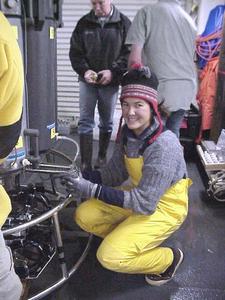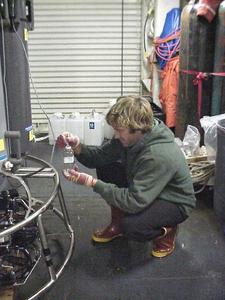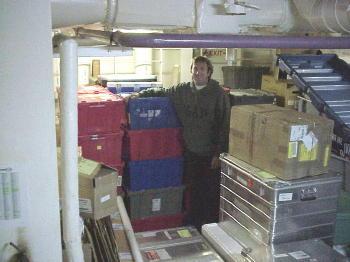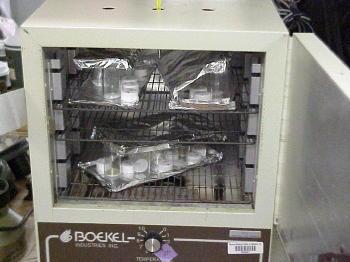2 August, 2002
We are on station on the East Barrow Canyon transect.
A transect is the sampling line we follow in a given
area. So far we have sampled on our way up along the
Alaskan Coast, and we have completed one transect,
Barrow Canyon. If you check the cruise course map on
the main page of the website, you can see that, on the
East Barrow transect, the stations are fairly close
together. We finished our benthic sampling by
midnight last night, moved to the next station, and
began the first CTD cast at 1 AM. The stations are
also shorter in general because we are only at 500
meters, and we will be moving to more shallow depths
as we progress along the transect. Once we move onto
the next transect line, we will go from shallow waters
over the shelf to deeper waters on the slope again.
Today I spoke with Christine Pequignet and Paul
Lethaby. Although Christine is from France and Paul
is from Wales, they are both research technicians
working at the Bermuda Biological Station for
Research. You can check out the place where they work
by going to www.bbsr.edu. Christine works with Nick
Bates, co-Principal Investigator (PI) on this project,
and Paul works on a program called BATS (Bermuda
Atlantic Time Series). Since 1988, the BATS program
has provided monthly data about the biological,
physical, geological, and chemical features of the
Atlantic Ocean water at one parcticular site off
Bermuda. On this SBI cruise, Christine and Paul are
sampling water to measure carbon in the water column
(at different depths).
Each time the CTD service cast comes on board, Paul
and Christine take two bottles of water from each of
the twelve bottles on the CTD rosette. Each bottle is
about one quarter of a liter (about the amount in a
can of soda), and each one must be transported back to
Bermuda for analysis. All totaled, Christine and Paul
will bring home 1000 bottled samples from this summer
cruise to add to the 800 bottles from the spring SBI
cruise. Once they are back at the lab in Bermuda,
someone else will process each bottle at a rate of ten
bottles/day. Paul is smiling in the picture below
(next to the boxes of bottles) because he is not the
one who has to process all the samples. His job will
be to compile all the data on the computer.
During one step of the carbon cycle, carbon dioxide
(CO2) is exchanged between the atmosphere and the
surface of the ocean where it is dissolved in the
water to become dissolved inorganic carbon (DIC) or
dissolved CO2. Once in the water, the CO2 can be used
by phytoplankton which convert it into parcticulate
organic carbon (POC) or it can remain dissolved in the
water in organic (DOC) or inorganic (DIC) form. If
the phytoplankton die and sink to the bottom they
become a part of the sediments that Jackie is
sampling. Thatís one way that the ocean removes CO2
from the atmosphere. When you read in the newspaper
that oceans can be a ďsinkĒ for CO2, they are
referring to the removal of CO2 from the atmosphere.
Sometimes the carbon from the dead phytoplankton stays
in the sediments, and sometimes it dissolves and is
released into the water again. The combination of the
parcticulate organic carbon (POC) and the dissolved
organic carbon (DOC) makes up the total organic carbon
(TOC). Christine and Paul filter the water samples
they take to determine POC. Do you remember Cindy
Moore (see my journal for July 20)? Cindy is
analyzing DOC, and her results will be combined with
those from Paul and Christine to get TOC. So POC +
DOC = TOC. Get it? Itís important to know what
happens to the carbon in the Arctic Ocean so
scientists can tell if the ocean is a sink (takes up
carbon from the atmosphere) or a source (adds carbon
to the atmosphere).
Christine and Paul also sample the water from each
depth to measure the alkalinity of the water. That
will help them to know how much of the CO2 is
re-dissolved in the water. The data from the science
service team is critical because the amount of CO2
that is re-dissolved depends on the chemistry
(temperature, salinity, etc.) of the water. By
knowing the amount that is re-dissolved, they can get
an idea of how much has changed because of biological
activity and how much carbon reaches the bottom.
Paul and Christine are measuring carbon in the water
column. Others on board measure the carbon in the
sediments, sample the plankton that use the carbon,
track the amount of light that reaches into the water
for the phytoplankton to use the carbon, analyze the
water for various chemical and physical factors, or
trace the water itself. All the projects on this SBI
cruise are tied together in an interdisciplinary
effort to understand the way carbon cycles through the
western Arctic Ocean.

Christine Pequignet is taking water from the CTD cast in order to sample for alkalinity and dissolved CO2 (also called dissolved inorganic carbon or DIC).

Paul Lethaby helps Christine collect water from each service cast. They will have 1000 bottles to take home from this cruise to add to the 800 collected on the spring SBI cruise.

These are just a few of the boxes of bottles which will be shipped back to the Bermuda Biological Station for analysis. Paul is smiling because he doesn't have to do the analysis. His job will be to compile all the data on the computer.

This is the filtration set up that Paul and Christine use to separate the parcticles from the water they sample.

This is the drying oven where each filter must be dried and stored in yet another bottle to be brought back for analysis. At least these bottles are smaller!
Contact the TEA in the field at
.
If you cannot connect through your browser, copy the
TEA's e-mail address in the "To:" line of
your favorite e-mail package.
|
